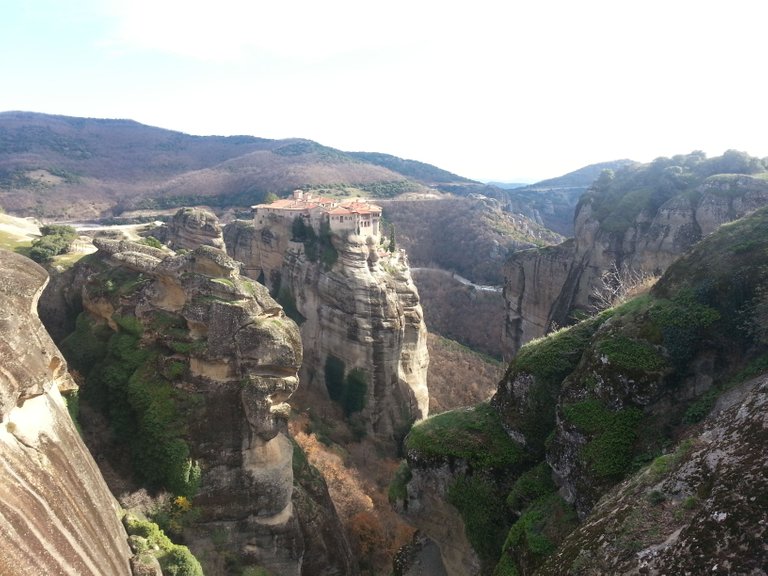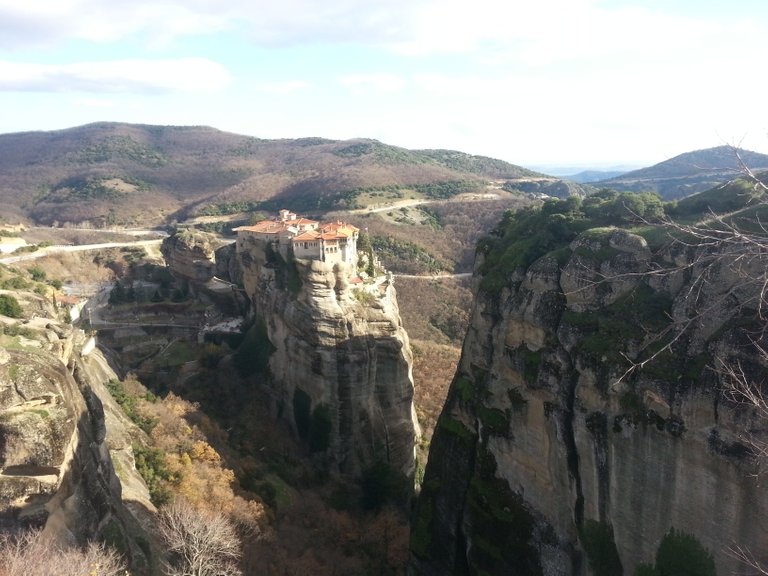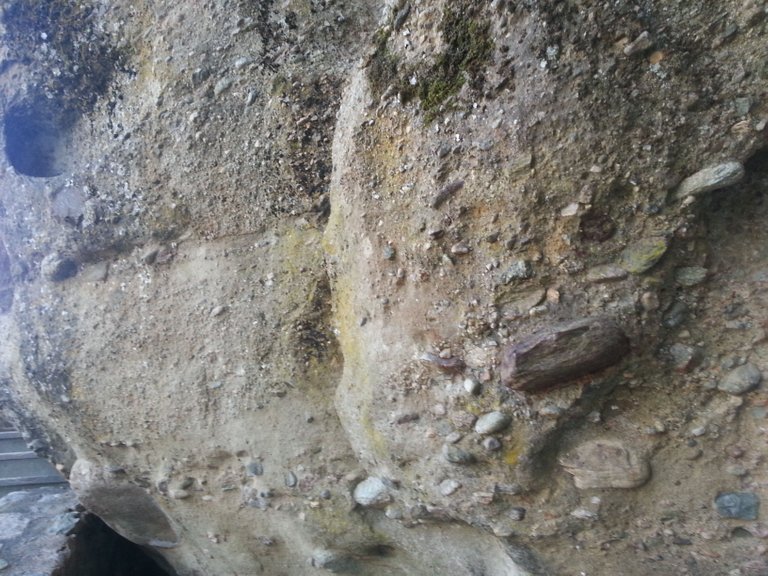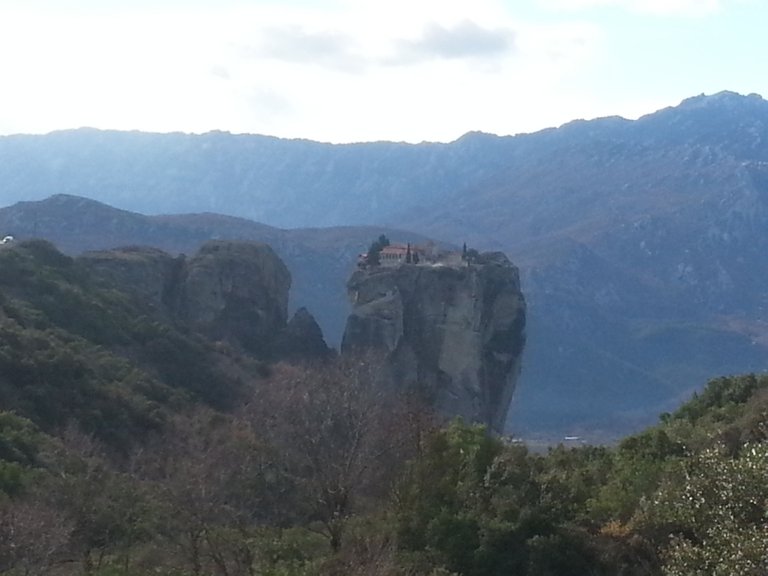
GEOLOGI
the Pindos Mountains, in the western region of Thessaly, these unique and enormous columns of rock rise precipitously from the ground. But their unusual form is not easy to explain geologically. They are not volcanic plugs of hard igneous rock typical elsewhere, but the rocks are composed of a mixture of sandstone and conglomerate.
The conglomerate was formed of deposits of stone, sand and mud from streams flowing into a delta at the edge of a lake, over millions of years. About 60 million years ago during the Paleogene period[5] a series of earth movements pushed the seabed upwards, creating a high plateau and causing many vertical fault lines in the thick layer of sandstone. The huge rock pillars were then formed by weathering by water, wind and extremes of temperature on the vertical faults. It is unusual that this conglomerate formation and type of weathering are confined to a relatively localised area within the surrounding mountain formation.
This type of rock formation and weathering process has happened in many other places locally and throughout the world, but what makes Meteora's appearance special is firstly the uniformity of the sedimentary rock constituents deposited over millions of years leaving few signs of vertical layering, and secondly the localised abrupt vertical weathering.
HISTORY - Caves in the vicinity of Meteora were inhabited continuously between 50,000 and 5,000 years ago. The oldest known example of a man-made structure, a stone wall that blocked two-thirds of the entrance to the Theopetra cave, was constructed 23,000 years ago, probably as a barrier against cold winds – the Earth was experiencing an ice age at the time – and many Paleolithic and Neolithic artifacts have been found within the caves.[6][7]
As early as the 11th century, monks occupied the caverns of Meteora. However, monasteries were not built until the 14th century, when the monks sought somewhere to hide in the face of an increasing number of Turkish attacks on Greece. At this time, access to the top was via removable ladders or windlass. Nowadays, getting up is a lot simpler due to steps being carved into the rock during the 1920s. Of the 24 monasteries, only 6 (five male, one female) are still functioning, with each housing fewer than 10 individuals.[8]
The cave of Theopetra is located 4 kilometres (2.5 mi) from Kalambaka. Its uniqueness from an archeological perspective is that a single site contains records of two greatly significant cultural transitions: the replacement of Neanderthals by modern humans and later, the transition from hunting-gathering to farming after the end of the last Ice Age. The cave consists of an immense 500 square metres (5,400 sq ft) rectangular chamber at the foot of a limestone hill, which rises to the northeast above the village of Theopetra, with an entrance 17 metres (56 ft) wide by 3 metres (9.8 ft) high. It lies at the foot of the Chasia mountain range, which forms the natural boundary between Thessaly and Macedonia prefectures, while the Lithaios River, a tributary of the Pineios River, flows in front of the cave. The small Lithaios River flowing literally on the doorsteps of the cave meant that cave dwellers had always easy access to fresh, clean water without the need to cover daily long distances to find it.[9] Excavations and research and have discovered petrified diatoms, which have contributed to understanding the Palaeo-climate and climate changes. Radiocarbon dating evidences human presence dating back 50,000 years.[6] The cave is open to the public.
MONASTERIES - In the 9th century AD, an ascetic group of hermit monks moved up to the ancient pinnacles; they were the first people to inhabit Meteora since the Neolithic Era. They lived in hollows and fissures in the rock towers, some as high as 1800 ft (550m) above the plain. This great height, combined with the sheerness of the cliff walls, kept away all but the most determined visitors. Initially, the hermits led a life of solitude, meeting only on Sundays and special days to worship and pray in a chapel built at the foot of a rock known as Dhoupiani.[2]
The exact date of the establishment of the monasteries is unknown. By the late 11th and early 12th centuries, a rudimentary monastic state had formed called the Skete of Stagoi and was centered around the still-standing church of Theotokos (mother of God).[2] By the end of the 12th century, an ascetic community had flocked to Meteora.
In 1344, Athanasios Koinovitis from Mount Athos brought a group of followers to Meteora. From 1356 to 1372, he founded the great Meteoron monastery on the Broad Rock, which was perfect for the monks; they were safe from political upheaval and had complete control of the entry to the monastery. The only means of reaching it was by climbing a long ladder, which was drawn up whenever the monks felt threatened.
At the end of the 14th century, the Byzantine Empire's reign over northern Greece was being increasingly threatened by Turkish raiders who wanted control over the fertile plain of Thessaly. The hermit monks, seeking a retreat from the expanding Turkish occupation, found the inaccessible rock pillars of Meteora to be an ideal refuge. More than 20 monasteries were built, beginning in the 14th century.[2] Six remain today.
In 1517, Nectarios and Theophanes built the monastery of Varlaam, which was reputed to house the finger of St John and the shoulder blade of St Andrew.
Access to the monasteries was originally (and deliberately) difficult, requiring either long ladders lashed together or large nets used to haul up both goods and people. This required quite a leap of faith – the ropes were replaced, so the story goes, only "when the Lord let them break".[10] In the words of UNESCO, "The net in which intrepid pilgrims were hoisted up vertically alongside the 373 metres (1,224 ft) cliff where the Varlaam monastery dominates the valley symbolizes the fragility of a traditional way of life that is threatened with extinction."[11]
Until the 17th century, the primary means of conveying goods and people from these eyries was by means of baskets and ropes.
In 1921, Queen Marie of Romania visited Meteora, becoming the first woman ever allowed to enter the Great Meteoron monastery.
In the 1920s there was an improvement in the arrangements. Steps were cut into the rock, making the complex accessible via a bridge from the nearby plateau. During World War II the site was bombed. Many art treasures were stolen.
Many art treasures were stolen.



Hi! I am a robot. I just upvoted you! I found similar content that readers might be interested in:
https://en.wikipedia.org/wiki/Meteora